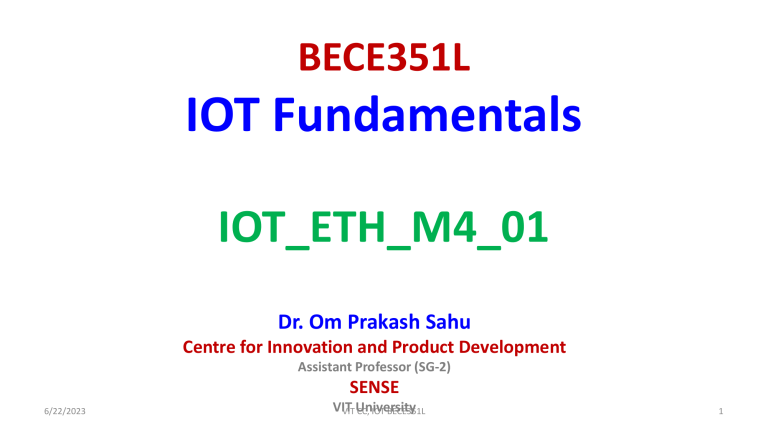
BECE351L IOT Fundamentals IOT_ETH_M4_01 Dr. Om Prakash Sahu Centre for Innovation and Product Development Assistant Professor (SG-2) SENSE 6/22/2023 VIT VIT University CC, IOT BECE351L 1 Module: 4 Edge Computing 1. Introduction to Edge/Fog computing 2. Front end Edge Devices 3. Gateway 4. Edge ML for Industry automation Introduction to Edge/Fog computing 6/22/2023 VIT CC, IOT BECE351L 3 Introduction to Edge/Fog computing Introduction to Edge/Fog computing How the technology reached today? • • • • Mainframes (centralized) Client server (distributed) Cloud computing (centralized) Edge computing (distributed) Introduction to Edge/Fog computing Cloud Computing • In Cloud Computing, either in public, private or hybrid types of accessibility models, data processing or computation occurs at the data center, where it has a substantial computational resource and data needs to be transferred back and forth. Gmail, Office 365, etc. Using software but using the cloud resource as hardware providing infrastructure, such as computing, storage, and cloud technology to the end-users Introduction to Edge/Fog computing What is Edge Computing • Edge computing is a distributed information technology (IT) architecture in which client data is processed at the periphery of the network, as close to the originating source as possible. Edge computing moves some portion of storage and compute resources out of the central data center and closer to the source of the data itself. Introduction to Edge/Fog computing What is Edge Computing • Edge Computing brings the decentralization of networks that allows to bring computation of data and storage too close to the source (where data is required). • Minimize the bandwidth, improve response time, and use of latency. Introduction to Edge/Fog computing What is Edge Computing • Edge computing is the computational processing of sensor data away from the centralized nodes and close to the logical edge of the network, toward individual sources of data. • Distributed IT network architecture that enables mobile computing for data produced locally. Introduction to Edge/Fog computing History of Edge Computing Instead of sending the data to cloud data centers, edge computing decentralizes processing power to ensure real-time processing without latency while reducing bandwidth and storage requirements on the network. Introduction to Edge/Fog computing Edge Vs. Cloud Computing Introduction to Edge/Fog computing Edge Vs. Cloud Computing Introduction to Edge/Fog computing Edge Vs. Cloud Computing Introduction to Edge/Fog computing Need for Edge Computing? • A novel distributed and large-scale computing paradigm is required to effectively treat and analyze such large-scale dataset in a timely manner. • Edge Computing model was introduced idea to bring data storage and compute power closer to the device or data source where it is mostly needed. • Edge Computing paradigm allows computing resources and application services to be distributed along the communication path, via decentralized computing infrastructures organised to treat in a hierarchical fashion the data analytic work flow. • The hierarchy coupled with the distribution of computing capabilities aims at solving the bandwidth bottleneck identified for general Cloud architectures. Introduction to Edge/Fog computing Edge Computing Edge Computing • Push from the Cloud Services • Push from the Internet of Things • Change from a Data Consumer to • a Producer Cloud Computing Introduction to Edge/Fog computing Edge Computing The objective of Edge Computing is to improve the network technology by moving the computation of data close to the edge of the network and away from the data centers. Introduction to Edge/Fog computing Edge Computing Architecture Introduction to Edge/Fog computing Edge Computing Architecture Cloudlet Computing: This refers to computing resources (small cluster) connected via WLAN the endusers. Acts as a data centre in a box which provides support (computing and storage) to the end-users over the WLAN network. Cloudlet Computing is based on three layers: • the component layer, • the node layer, and • the cloudlet layer. This is designed to have • higher bandwidth, and • lowering the latency for the applications. Introduction to Edge/Fog computing Edge Computing Architecture Fog Computing, • a decentralised computing resource that can be placed anywhere between the cloud and the end-users. • Fog computing utilizes Fog Computing Nodes (FCNs). FCNs: • heterogeneous, including switches, routers, and access points. • heterogeneous environment facilitates the devices at different protocol layers and non-IP based technologies to communicate between the FCNs and the end device. • hidden for the end-users, thus ensuring security. Introduction to Edge/Fog computing Edge Gateways • An edge gateway processes data from edge devices, sending back relevant data, providing network translation between networks using different protocols and ultimately reducing bandwidth needs. • “gateway” name certainly fits, since it connects sensors and nodes at one end, provides one or multiple local functions, and extends bidirectional communications to the cloud. Interestingly, edge devices often serve as gateways. • Edge Computing Architecture Multi-access Edge Computing (MEC): • • • refers to implementing Edge Computing within the Radio Access Network to reduce the latency. Formally known as Mobile Edge Computing, it is an ETSI-defined network architecture located closer to the Radio Network Controller or macro base station. The edge orchestrator organizes the MEC, provides network information about load and capacity, and offers information to the end-users about their location and network information. Edge Computing Architecture IoT (Internet of Things) • contains a large set of devices and sensors that produce a huge volume of data. • exchange the data through a modern communication network and monitor and control the infrastructure. • end-users at the Edge use the IoT devices and sensors. Edge Computing Architecture Edge Computing aims to bring computational power in close proximity of IoT sensors, smartphones, and connected technologies. Real-Life Use Cases for Edge Computing Real-Life Use Cases for Edge Computing Autonomous vehicle (AV) Real-Life Use Cases for Edge Computing Healthcare Devices Real-Life Use Cases for Edge Computing Security Solutions Real-Life Use Cases for Edge Computing Retail Advertising Real-Life Use Cases for Edge Computing Smart Speakers Real-Life Use Cases for Edge Computing Video Conferencing Advantages of Edge Computing • Increasing data security and privacy • Better, more responsive and robust application performance • Reducing operational costs • Improving business efficiency and reliability • Unlimited scalability • Conserving network and computing resources Disadvantages of Edge Computing • Requires more storage as data will be placed and processed at different and various locations. • Data is kept on distributed locations, and security becomes a challenging task in such an environment. It often becomes risky to identify thefts and cybersecurity issues. Also, if some new IoT devices are added, it can open gates for the attackers for harming the data. • It is known that edge computing saves many expenses in purchasing new devices, but edge computing is also expensive. It means the cost is too high. • It needs advanced infrastructure for processing data in an Challenges in Edge Computing Front end Edge Devices 6/22/2023 VIT CC, IOT BECE351L 34 Front end Edge Devices • Edge devices are pieces of equipment that serve to transmit data between the local network and the cloud. • They are able to translate between the protocols, or languages, used by local devices into the protocols used by the cloud where the data will be further processed. • Local devices use protocols like Bluetooth, wi-fi, Zigbee, and NFC while the cloud uses protocols like AMQP, MQTT, CoAP, and HTTP. • In order for IoT data to move between the cloud and local devices, an edge device—like a smart gateway—translates, sorts, and securely transfers information between the two sources. Front end Edge Devices Front end Edge Devices Edge Devices • Edge Routers: Edge routers connect multiple packet transmission networks. They manage data traffic to an IP address so multiple devices can operate using a single internet connection. • WAN Devices: Wide Area Network (WAN) devices extend over large areas and can even be global. • Routing Switches: Routing switches perform many of the same functions as a router but also allow connections across different devices. • Firewalls: Firewalls monitor all network traffic for security. They contain rules-based functionality and can be configured to block data traffic deemed harmful by the rule set. • Multiplexers: Multiplexers merge data from multiple data sources over a single signal. They’re integrated access devices (IAD) that help automation systems and advanced IoT networks perform efficiently. Front end Edge Devices Intelligent Edge Devices • Sensors: Sensors measure a condition or event, trigger action, and route data to the next destination. Sensor types are almost limitless and include GPS, motion, optical, temperature, humidity, vibration, and more. • Actuators: Actuators act as the physical connectivity bridge between electronic devices like sensors and the physical movement required on a machine. Actuators take the sensor signals and instructions from intelligent edge devices and trigger actions using electric, air, or hydraulic power. • IoT Gateways: IoT gateways connect multiple sensors and other devices to cloud computing platforms for analytics, computing, processing, and storage. • M2M Devices: M2M devices connect equipment or machines to transfer data and facilitate automation. Front end Edge Devices How does Edge Devices Work? a combination of sensors, actuators, routers, switches, and edge computing devices can be controlled and accessed locally or over WAN to provide visibility and the capability to act over long distances. • If the data is informational or transactional, the device may send it directly to the cloud for storage. Or, based on parameters, it may send it to an edge device for processing and instructions and then forward the instructions to an actuator to trigger a response. • Devices like embedded or added sensors act as the device layer, acquiring data and sending it to the edge computing device or a cloud computing platform. Edge Gateways • • An edge gateway processes data from edge devices, sending back relevant data, providing network translation between networks using different protocols and ultimately reducing bandwidth needs. “gateway” name certainly fits, since it connects sensors and nodes at one end, provides one or multiple local functions, and extends bidirectional communications to the cloud. • Interestingly, edge devices often serve as gateways. Edge Gateways Edge Gateways Industrial Edge Computing Requirements for Industrial Edge Computing Industrial Edge Computing Edge ML for Industrial Automation • Edge AI is the class of ML architecture in which the AI algorithms process the data on the edge of the network (the place where data is generated, i.e., locally) instead of sending it to the cloud. • The nature of the edge architecture makes it a perfect fit for reducing the inefficiencies in the existing systems. • Operational Efficiency- Significantly reduces latency, enhancing the real-time decision-making capabilities. • Enhanced Security- It increases the level of security in terms of data privacy through local processing. Data is no longer shared in a centralized cloud. • Decentralization of Workloads- Decentralization of the Processing makes all the distributed systems efficient and self-sustained. Edge ML for Industrial Automation •Data Ingestion and Storage of the Data : The real-time sensor data from the monitoring system of machines into the pipeline. The stream of the data will be stored locally and securely as no cloud processing is involved here. •Processing: This stage of the pipeline will process the data according to the need of the pre-trained models. •Analysis: Here the data will be analyzed by the models, and they will give the results. •Results: This stage will compile the results. And after these Results, the Response can be taken by the stakeholders. Use cases of Edge AI • Predictive Maintenance refers to the ability to pre-emptively detect the failure of machines using machine learning predictive algorithms. • Predictive Maintenance has been in the industry for some time, but it has also been difficult to implement. • Condition-based Monitoring: Challenges in fetching the data from their machines, processes, and system. Whether the streams are sent to the cloud and Then processing is done. • If some initial filtering can be done, then only useful data streams can be utilized in the cloud or locally, this can be achieved with edge ai near the data generation streams. • Precision monitoring and controlling system: Use a large amount of data Machine learning algorithms. • Edge Computing is a perfect fit for it as it can collect, aggregate, and filter the data used by the AI/ML algorithms. Case Studies • • • • • • UAV‐based LoRaWAN flying gateway for the internet of flying things LoRa Based IoT Platform for Remote Monitoring of Large-Scale Agriculture Farms in Chile Edge Computing Application, Architecture, and Challenges in Ubiquitous Power Internet of Things An internet of radiation sensor system (IoRSS) to detect radioactive sources out of regulatory control LoRaWAN for Smart Campus: Deployment and Long-Term Operation Analysis Forest 4.0: Digitalization of forest using the Internet of Things (IoT) Dr. Om Prakash Sahu Assistant Professor (SG-2) SENSE, VIT University 09827889143 Email Id : omprakash.sahu@vit.ac.in



